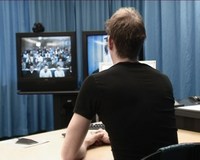3. Improve your Studio
A necessary condition for being able to carry out a good
video lecture is to feel comfortable with all circumstances
in your video conferencing studio, i.e. with all equipments
you are going to use, the furnishing, colours, sound and picture
quality of both you and the far end part(ies).
Equipments
All equipments should be correctly connected to your video
conferencing system and work properly. It is of fundamental
importance that you have carried out systematic testing in
advance to ensure that you know how to operate the gadgets
you are planning to use, and that there are no known technical
problems with them when the lecture begins. If you feel uncertain
about some of the equipments, this can influence your performance
substantially, as you often will become more defensive or
passive. That is not a good starting point for a video lecture.
One of the most important factors is that you are really pushing.
2 - 3 nice looking camera presets should be programmed on
the remote control to cover your standing or seating other
places. If you will be seated by the teacher's desk all the
lecture, it could be smart to switch between some different
camera presets, i.e. different zoom and different camera angles
if you have got more than one camera. We see that the broadcasting
companies use this trick in the news to achieve some variation
during the session.
Furniture and placement of gadgets
The furnishing should be complete and comfortable with enough
places on the desk for lecture notes, mouse and a PC keyboard.
If the PC screen is placed on the desk, it shouldn't cover
you or your face in the camera view. The document camera should
not be placed in front of you, but reachable from where you
sit or stand. When you are standing in front of the digital
whiteboard, it is important that only a part of the bright
board surface is within the camera view, otherwise both you
and the surroundings will become too dark on the screen. It
is important that your room looks tidy and that the curtains
are stretched and look properly on the monitor.
 In
the first video clip we demonstrate the result when filming
a person in front of a bright digital whiteboard. If the bright
surface covers almost all the camera view, the person in front
becomes too dark. The solution is to zoom out slightly, such
that the bright surface only covers a portion of the camera
view. In the second clip we suggest how the camera should
be placed in order to achieve as good as possible eye-contact
with the audience during the lesson. In
the first video clip we demonstrate the result when filming
a person in front of a bright digital whiteboard. If the bright
surface covers almost all the camera view, the person in front
becomes too dark. The solution is to zoom out slightly, such
that the bright surface only covers a portion of the camera
view. In the second clip we suggest how the camera should
be placed in order to achieve as good as possible eye-contact
with the audience during the lesson.
|
VIDEO CLIP |
DESCRIPTION |
|

|
This video
highlights the problem of filming a person in front
of an illuminated surface, as the subject will become
very dark. We suggest a work-around solution for this. |
|

|
Demonstrates
how to place the camera close to the screen as to maintain
eye contact with the camera. |
Microphone solutions
If you wear a wireless microphone, you don ´t have to bother
whether the sound is OK if you move to the digital whiteboard
or other places in your room. But you should be careful to
use good or fully charged batteries at the beginning of your
lecture, and always have access to batteries for replacement.
Cheek microphones mounted on the neck give a relative constant
input signal, while lavaliere microphones connected to the
shirt get a low input signal when your head is turning away
to one side. Besides, this latter type of microphone is sensitive
to noise from the clothes.
If you are using table-top microphone(s) or another stationary
solution, it is important that all your positions are covered
by at least one microphone. Either you have to carry the microphone
to the new position, or you have to place microphones in advance
to all your planned positions.
Colours
The walls of your studio should be covered by thick curtains
of a nice colour. Blue curtains are often used to give visually
good pictures from you, and thick curtains and carpets improve
the acoustic properties of your studio. When you speak or
make sounds from some presentation, sound waves are reflected
between the floor, ceiling and the walls, and thick curtains
on the walls and carpets on the floor reduce these audio reflections.
You should wear one-coloured clothes that matches the background
colours. Avoid white and black clothes, as this introduces
problems with light adjustments. If you wear a white shirt,
the automatic light adjustment of your video system and camera
will reduce the total light level, implying that all other
objects and your surroundings will become too dark on the
screens. On the other hand, if you wear black clothes, the
surroundings will become too bright on the screen. Light blue,
light green and light brown are colours that are reasonable
safe to use on your clothes.
 This
video clip is summarizes some unfortunate details of a video
lecture. The clothes have an unfortunate colour, the camera
view becomes poor, there are no camera presets, and tuning
the camera "on the fly" is never a good thing to do. This
video clip is summarizes some unfortunate details of a video
lecture. The clothes have an unfortunate colour, the camera
view becomes poor, there are no camera presets, and tuning
the camera "on the fly" is never a good thing to do.
|
VIDEO CLIP |
DESCRIPTION |
|

|
In this sequence we invite the viewer
to watch through a thoroughly bad lecture, and write
down all the mistakes that the lecturer does in front
of the camera |
Noise
Microphones are "stupid" objects, i.e. they do not separate
useful sound from noise. All kinds of noise in your room are
regarded as useful sounds, and will be input to the microphones
and transmitted to the other parties. The most common noise
sources are:
- Noise from you and other people present in your room.
Even whispering and turnover of paper leaves may create
irritating noise to the other parties, although you almost
can´t hear it in the room yourself.
- Noise from fans and heating equipments.
- Noise from computers, servers and the video conferencing
system itself.
- Noise from activities in nearby rooms, i.e. people walking,
talking, laughing, pulling chairs etc.
- Traffic noise from the outside.
Ventilation fans and other noise sources from your room may
have to be switched off during the video lecture. Computers
and servers may be placed in special cupboards that reduce
the noise substantially. If the noise from other rooms or
outside the building is problematic, it could be necessary
to find a more suitable room in calmer surroundings another
place. However, your video conferencing room should regularly
be examined carefully with respect to noise sources and reduction
of noise.
|

